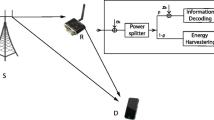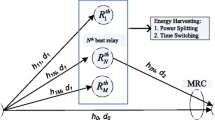Abstract
Cooperative communication systems with wireless power transfer are being investigated for future advanced wireless networks. In this research, we propose applying a wireless power transfer to dual-hop cooperative communication systems, in which a relay node harvests the energy from the radiofrequency in order to forward the received signal, and a source node can communicate with a destination node directly or through the selected relay nodes. The system performance is evaluated by an outage probability that is calculated over independent and identically distributed (i.i.d) Nakagami-m distributions in two scenarios, i.e., integer m and arbitrary m. Furthermore, the closed forms of the outage probability expressions are derived in the case of both the amplify-and-forward (AF) and decode-and-forward (DF) protocols. The Monte Carlo method is utilized to simulate the system with the aims of evaluating the system performance and verifying the theoretical analysis. The numerical results highlight that the proposed calculation method and the closed form of the outage probability are accurate. We also compare the system performance of both the AF and DF protocols and show the effect of parameter m on the performance of the system.







Similar content being viewed by others
Notes
The power splitting architecture can be applied directly
References
Laneman JN, Tse DN, Wornell GW (2004) Cooperative diversity in wireless networks: efficient protocols and outage behavior. IEEE Trans Inf Theory 50(12):3062–3080
Bletsas A, Shin H, Win MZ (2007) Cooperative communications with outage-optimal opportunistic relaying. IEEE Trans. Commun. 6(9):3450–3460
Duy TT, Duong TQ, Benevides da Costa D, Bao VNQ, Elkashlan M (2015) Proactive relay selection with joint impact of hardware impairment and co-channel interference. IEEE Trans Commun 63(5):1594–1606
Duong TQ, Bao VNQ, Zepernick H-J (2009) On the performance of selection decode-and-forward relay networks over Nakagami-m fading channels. IEEE Commun Lett 13(3):172–174
Lu X, Wang P, Niyato D, Kim DI, Han Z (2015) Wireless networks with RF energy harvesting: a contemporary survey. IEEE Commun Tutorials 17(2):757–789
Zhao L, Wang X, Zheng K (2016) Downlink hybrid information and energy transfer with massive MIMO. IEEE Commun Mag 15(2):1390–1322
Vahidnia R, Anpalagan A, Mirzaei J (2016) Diversity combining in bi-directional relay networks with energy harvesting nodes. IET Commun 10(2):207–211
Do NT, Bao VNQ, An B (2015) A relay selection protocol for wireless energy harvesting relay networks. Proc 2015 12th Adv Tech Commun (ATC) 10(2):243–247
Son PN, Kong HY, Anpalagan A (2016) Exact outage analysis of a decode-and-forward cooperative communication network with Nth best energy harvesting relay selection. Ann Telecommun 71 (5-6):251–263
Chen Y (2016) Energy-harvesting AF relaying in the presence of interference and Nakagami-fading. IEEE Trans Commun 15(2):1008–1017
Dong Y, Hossain M, Cheng J (2016) Performance of wireless powered amplify and forward relaying over Nakagami-m fading channels with nonlinear energy harvester. IEEE Commun Lett 20(4):672–675
Hoang TM, Duy TT, Bao VNQ (2016) On the performance of non-linear wirelessly powered partial relay selection networks over rayleigh fading channels. Proc 2016 3rd Nat Found Science and Tech Dev Conf (NICS) 10(2):6–11
Hoang TM, Tan NT, Hoang NH, Hiep PT (2018) Performance analysis of decode-and-forward partial relay selection in noma systems with rf energy harvesting. Wireless Networks, pp 1–11. https://doi.org/10.1007/s11276--018--1746--8
Psannis KE, Stergiou C, Gupta BB (2018) Advanced media-based smart big data on intelligent cloud systems. IEEE Trans Sustain Comput 4(1):77–87
Plageras AP, Psannis KE, Stergiou C, Wang H, Gupta BB (2018) Efficient IoT-based sensor big data collection–processing and analysis in smart buildings. Futur Gener Comput Syst 82:349–357
Hoang TM, Son VV, Dinh NC, Hiep PT (2018) Optimizing duration of energy harvesting for downlink noma full-duplex over Nakagami-m fading channel. Int J Electron Commun. (AEÜ) 95:199–206
Zwillinger D (2014) Table of integrals, series, and products. Elsevier
Bao VNQ, Kong HY (2010) Performance analysis of decode-and-forward relaying with partial relay selection for multihop transmission over Rayleigh fading channels. J Commun Netw 12(5):433–441
Nasir AA, Zhou X, Durrani S, Kennedy RA (2013) Relaying protocols for wireless energy harvesting and information processing. IEEE Trans Wirel Commun 12(7):3622–3636
Senaratne D, Tellambura C (2010) Unified exact performance analysis of two-hop amplify-and-forward relaying in Nakagami m fading. IEEE Trans Veh Technol 59(3):1529–1534
Krikidis I, Timotheou S, Sasaki S (2012) RF Energy transfer for cooperative networks: data relaying or energy harvesting?. IEEE Commun Lett 16(11):1772–1775
Sudevalayam S, Kulkarni P (2011) Energy harvesting sensor nodes: survey and implications. IEEE Commun Surv Tuts 13(3):443–461
Krikidis I, Zheng G, Ottersten B (2013) Harvest-use cooperative networks with half/full-duplex relaying. In: Wirel Commun and Netw Conf (WCNC). IEEE, pp 4256–4260
Fedele G (1996) N-Branch diversity reception of mary DPSK signals in slow and non selective Nakagami m fading. IEEE Trans Commun Technol 7(2):119–123
Hung C-C, Chiang C-T, Yen N-Y, Wu R-C (2010) Outage probability of multiuser transmit antenna selection/maximal-ratio combining systems over arbitrary Nakagami-m fading channels. IET Commun 4(1):63–68
Acknowledgments
The authors would like to thank Dr. Vu Van Son and Dr. Dinh Trieu Duong for their valuable comments which helped improve the quality of this work.
Funding
This research is funded by the Vietnam National Foundation for Science and Technology Development (NAFOSTED) under grant number 102.04-2017.311
Author information
Authors and Affiliations
Corresponding author
Additional information
Publisher’s note
Springer Nature remains neutral with regard to jurisdictional claims in published maps and institutional affiliations.
Appendix: The proof of term \({\mathbb J}(a,b) \)
Appendix: The proof of term \({\mathbb J}(a,b) \)
Combining (8), (9), and (11), function \({\mathbb J}(a,b)\) can be rewritten as:
where \({\gamma _{{\text {th}}}} = {2^{\frac {{2{\mathcal R}}}{{1 - \alpha }}}} - 1\); \(a = \frac {{{\gamma _{\text {{th}}}}}}{{{P_{\text {S}}}}}, {and} b = \frac {{\left ({1 - \alpha } \right ){\gamma _{\text {{th}}}}}}{{2\alpha \eta {P_{\text {S}}}}}\).
The expansion of the incomplete gamma function by a series development is applied for \(\gamma \left ({m,z} \right )\) [25, Eq. 5].
From Eq. 42, it is clear that when the Nakagami-m fading parameter is not an integer, the CDF can be expressed as a single infinity series of incomplete gamma functions.
Substituting (42) into (18) and after some algebraic manipulations, we obtain the PDF of the instantaneous SNR over the first hop.
Based on [17, 0.314], Eq. 43 is rewritten as:
where ck is defined as
The CDF and PDF of the individual links are already obtained by Eqs. 2 and 44; consequently, the CDF of link S-R-D can be derived as:
where \(b = \frac {{\left ({1 - \alpha } \right ){\gamma _{{\text {th}}}}}}{{2\alpha \eta {P_{\text {S}}}}} {\text {and}} a = \frac {{{\gamma _{{\text {th}}}}}}{{{P_{\text {S}}}}}\).
With high transmission power, parameter a can be approximated as \(a = \frac {{{\gamma _{{\text {th}}}}}}{{{P_{\text {S}}} \to \infty }} \approx 0\). Hence, \(\mathbb {J}\left ({a,b} \right )\) is changed.
with v = Nm1 + k − m2 − j − 1.
Applying [17, Eq:3.471.9], we have
and then the approximation of \(\mathbb {J}\left ({a,b} \right )\) in Eq. 47 is changed, as in Eq. 27.
To analyze the exact outage probability expression, Eqs. 2 and 44 are substituted into Eq. 46, and we obtain function \(\mathbb {J}\left ({a,b} \right )\).
To calculate \(\mathbb {J}_{1}\), [17, 3.351.2] can be used, while to calculate \(\mathbb {J}_{2}\), the variable x is replaced with x = au, and then we obtain (24). Finally, we consider the system model in the two cases of index power v ≥ 0andv < 0, in which [17, 3.351.2] is used for the case v ≥ 0 and the exponential integral function is used for the case v < 0. We completely prove the proposition 1 here.
Rights and permissions
About this article
Cite this article
Vinh, H.D., Hoang, T.M. & Hiep, P.T. Outage probability of dual-hop cooperative communication networks over the Nakagami-m fading channel with RF energy harvesting. Ann. Telecommun. 76, 63–72 (2021). https://doi.org/10.1007/s12243-020-00821-z
Received:
Accepted:
Published:
Issue Date:
DOI: https://doi.org/10.1007/s12243-020-00821-z




